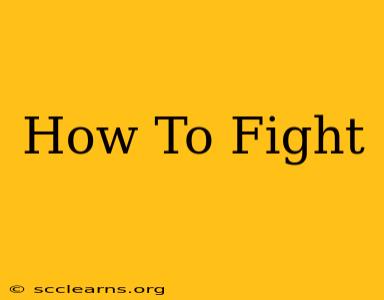Learning how to fight isn't just about throwing punches; it's about self-preservation and de-escalation. This guide explores effective self-defense techniques and strategies, emphasizing safety and responsible use of force. Remember, the best fight is the one you avoid.
Understanding the Importance of Self-Defense
Before diving into techniques, it's crucial to understand the gravity of physical confrontation. Self-defense is about protecting yourself from harm, and it's important to act only when necessary. This means prioritizing de-escalation and avoidance whenever possible.
Prioritizing Avoidance and De-escalation
- Situational Awareness: Be aware of your surroundings. Avoid walking alone in poorly lit areas at night and trust your instincts. If a situation feels unsafe, remove yourself.
- Verbal De-escalation: A calm and assertive tone can often diffuse a tense situation. Avoid escalating the conflict through aggressive language or body language.
- Body Language: Maintain confident, open body language but avoid appearing aggressive or challenging.
Basic Self-Defense Techniques
If avoidance and de-escalation fail, you need to know how to protect yourself. These are basic techniques, and professional training is highly recommended for comprehensive knowledge.
Striking Techniques
- Punches: Focus on powerful, short punches aimed at vulnerable areas like the nose, eyes, throat, or groin. Use proper technique to avoid injuring yourself.
- Kicks: Kicks can be devastating if executed correctly. Target the knees, groin, or shin.
- Elbows and Knees: These are powerful close-range weapons.
Grappling and Escapes
- Escaping a Grapple: If someone grabs you, use your arms and legs to break free. Create distance and escape the hold.
- Ground Defense: If taken to the ground, protect your head and try to regain a standing position.
Beyond the Physical: Mental Preparedness
Effective self-defense involves more than just physical techniques. Mental preparedness is equally crucial.
Building Confidence
- Self-Assertiveness Training: Learn to project confidence and set boundaries. This can deter potential attackers.
- Mindfulness and Situational Awareness: Develop your awareness of your environment and potential threats.
- Regular Exercise: Physical fitness builds strength, stamina, and resilience.
Seeking Professional Training
While this guide provides a basic overview, it's strongly recommended to seek professional training in self-defense. A qualified instructor can teach you proper techniques, strategies, and safety precautions. This will equip you with the knowledge and skills to handle dangerous situations effectively and safely.
Different martial arts disciplines offer various self-defense skills:
- Martial Arts: Disciplines like Krav Maga, Brazilian Jiu-Jitsu, Muay Thai, and Judo provide comprehensive self-defense training.
Remember: Your safety is paramount. Always prioritize de-escalation and avoidance. This guide serves as an introduction only; professional training is essential for effective and safe self-defense.

